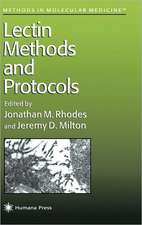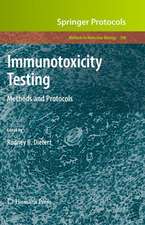Molecular Typing in Bacterial Infections: Infectious Disease
Editat de Ivano de Filippis, Marian L. McKeeen Limba Engleză Paperback – 13 dec 2014
Din seria Infectious Disease
- 5%
 Preț: 1435.28 lei
Preț: 1435.28 lei - 5%
 Preț: 1430.35 lei
Preț: 1430.35 lei - 18%
 Preț: 723.51 lei
Preț: 723.51 lei - 5%
 Preț: 801.13 lei
Preț: 801.13 lei - 5%
 Preț: 683.03 lei
Preț: 683.03 lei - 5%
 Preț: 1110.72 lei
Preț: 1110.72 lei - 5%
 Preț: 1094.25 lei
Preț: 1094.25 lei - 5%
 Preț: 1414.80 lei
Preț: 1414.80 lei - 5%
 Preț: 1101.37 lei
Preț: 1101.37 lei - 5%
 Preț: 790.88 lei
Preț: 790.88 lei - 5%
 Preț: 1027.15 lei
Preț: 1027.15 lei - 5%
 Preț: 1364.22 lei
Preț: 1364.22 lei - 5%
 Preț: 2038.62 lei
Preț: 2038.62 lei - 18%
 Preț: 944.99 lei
Preț: 944.99 lei - 5%
 Preț: 1414.29 lei
Preț: 1414.29 lei - 5%
 Preț: 1113.99 lei
Preț: 1113.99 lei - 5%
 Preț: 1431.81 lei
Preț: 1431.81 lei - 5%
 Preț: 1121.69 lei
Preț: 1121.69 lei - 5%
 Preț: 1117.65 lei
Preț: 1117.65 lei - 5%
 Preț: 1612.30 lei
Preț: 1612.30 lei - 5%
 Preț: 723.05 lei
Preț: 723.05 lei - 18%
 Preț: 1253.42 lei
Preț: 1253.42 lei - 5%
 Preț: 1321.71 lei
Preț: 1321.71 lei - 5%
 Preț: 1427.62 lei
Preț: 1427.62 lei - 5%
 Preț: 725.04 lei
Preț: 725.04 lei - 5%
 Preț: 712.60 lei
Preț: 712.60 lei
Preț: 1280.72 lei
Preț vechi: 1561.84 lei
-18% Nou
Puncte Express: 1921
Preț estimativ în valută:
245.09€ • 266.14$ • 205.88£
245.09€ • 266.14$ • 205.88£
Carte tipărită la comandă
Livrare economică 22 aprilie-06 mai
Preluare comenzi: 021 569.72.76
Specificații
ISBN-13: 9781627039420
ISBN-10: 1627039422
Pagini: 496
Ilustrații: XII, 484 p.
Dimensiuni: 155 x 235 x 26 mm
Greutate: 0.69 kg
Ediția:2013
Editura: Humana Press Inc.
Colecția Humana
Seria Infectious Disease
Locul publicării:Totowa, NJ, United States
ISBN-10: 1627039422
Pagini: 496
Ilustrații: XII, 484 p.
Dimensiuni: 155 x 235 x 26 mm
Greutate: 0.69 kg
Ediția:2013
Editura: Humana Press Inc.
Colecția Humana
Seria Infectious Disease
Locul publicării:Totowa, NJ, United States
Public țintă
ResearchCuprins
Section 1: General consideration on microorganism typing methods.- Molecular epidemiology.- Section 2: Gastrointestinal Pathogens.- Enterococci.- Listeria monocytogenes.- Enterobacteriaceae.- Vibrio cholerae.- Clostridium difficile.- Oral and Intestinal Bacteroidetes.- Section 3: Oral and Respiratory Pathogens.- Streptococci.- Streptococcus mutans.- Periodontal anaerobic bacteria.- Nontuberculous mycobacteria.- Neisseria meningitidis.- Haemophilus influenzae.- Moraxella.- Legionella pneumophila.- Mycoplasma and Ureaplasma.- Corynebacterium diphtheriae.- Burkholderia.- Section 4: Urogenital Pathogens.- Treponema.- Chlamydiaceae.- Section 5: Vector Borne Pathogens.- Borreliae.- Erysipelothrix.- Section 6: Pathogens causing Healthcare-Associated Infection.- Staphylococci.- Pseudomonas.- Section 7: Emerging and Reemerging Pathogens.- Acinetobacter baumannii.- Coxiella burnetii.- Index.
Textul de pe ultima copertă
The accurate identification and typing of microbes is essential for researchers in all fields of microbiology. The investigation of species diversity is crucial for the determination of the genetic relatedness of isolates for epidemiological studies. The development of molecular genotyping methods has improved the classification and typing of microorganisms at the sub-species level. In Molecular Typing in Bacterial Infections, readers will find an ultimate guide to molecular methods for the classification and typing of most human bacterial pathogens, covering a wide range of techniques which can be easily applied to the investigation of infectious diseases.
The emphasis is on nucleic acid-based assays and alternative biochemically and immunologically-based formats providing significant potential improvement of typing technologies that are transforming the field of diagnostic testing.
Comprehensive and practical, Molecular Typing in Bacterial Infections provides state-of-the-art methods not only for accurate diagnostic, but also for the correct classification of different types which will prove to be critical in unraveling the routes of spread of human pathogens.
The emphasis is on nucleic acid-based assays and alternative biochemically and immunologically-based formats providing significant potential improvement of typing technologies that are transforming the field of diagnostic testing.
Comprehensive and practical, Molecular Typing in Bacterial Infections provides state-of-the-art methods not only for accurate diagnostic, but also for the correct classification of different types which will prove to be critical in unraveling the routes of spread of human pathogens.
Caracteristici
A valuable resource for molecular typing of infectious diseases agents Useful in both research and hospital clinical lab settings Methods discussed can be used to differentiate bacterial pathogens and identify linkage to outbreaks Includes supplementary material: sn.pub/extras












